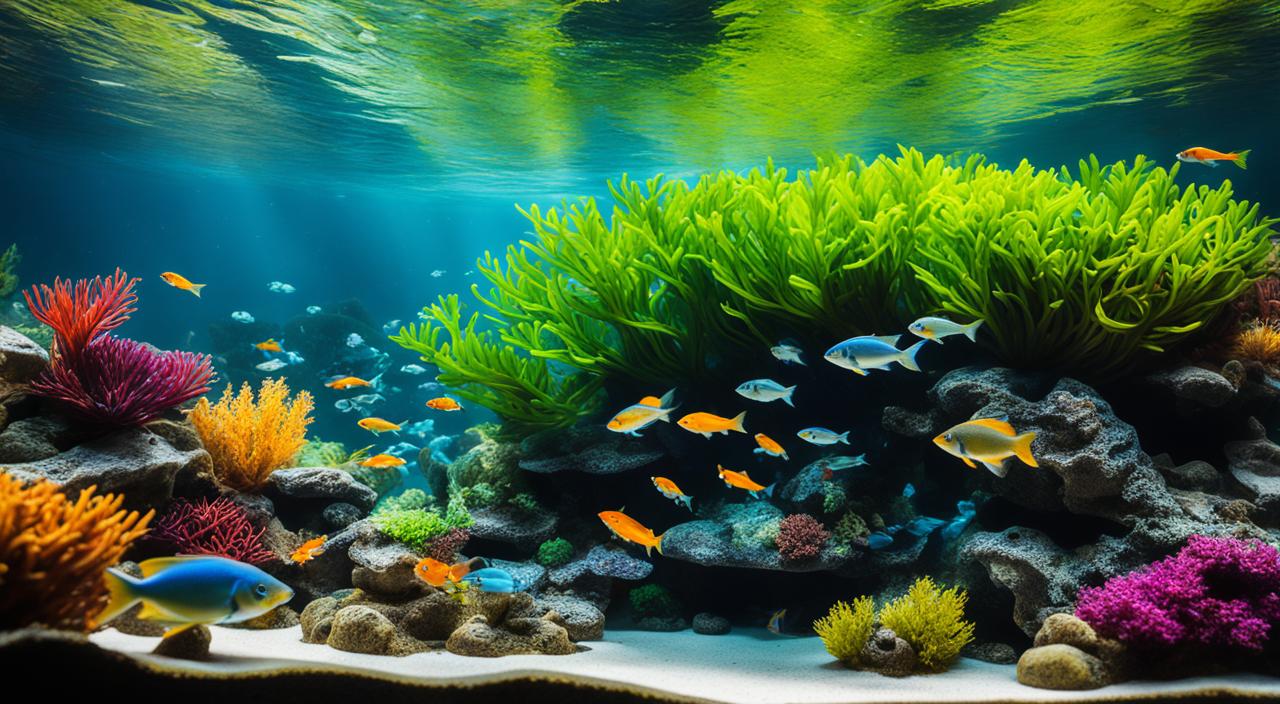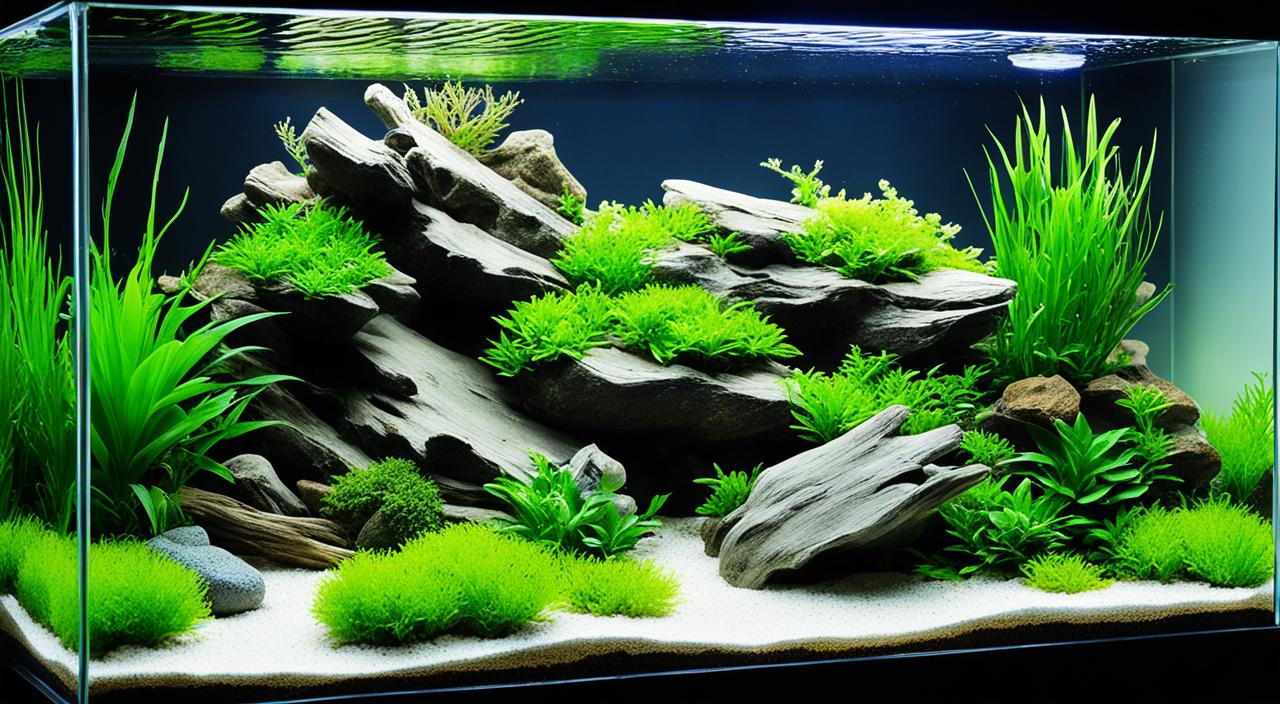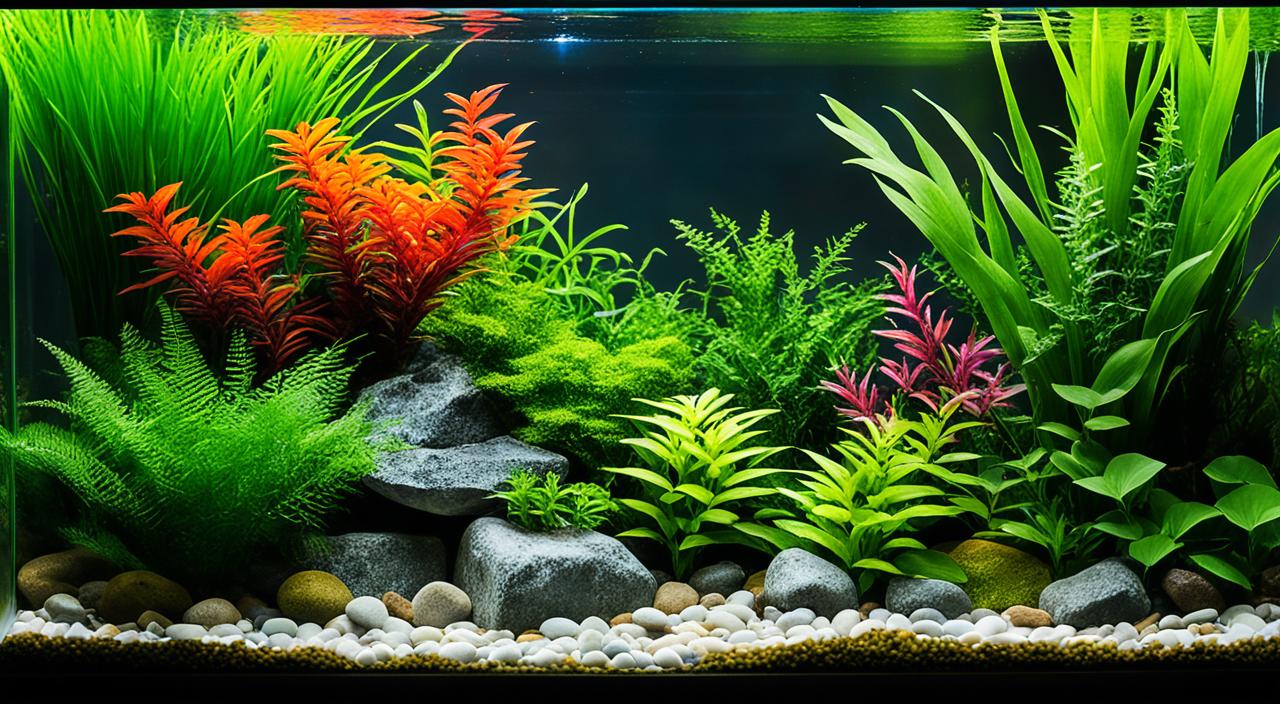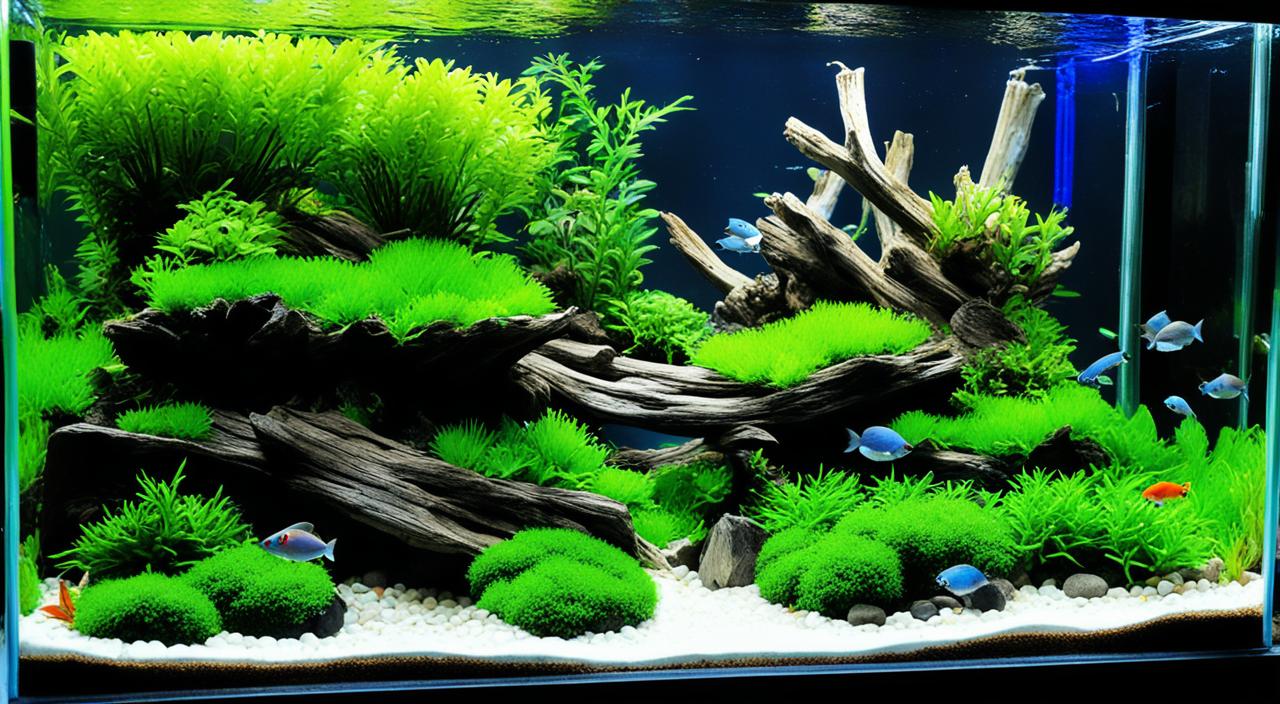Aquascaping is an art form that allows me to create stunning underwater landscapes in my aquarium, bringing the beauty and tranquillity of natural habitats into my own home. Whether you’re a beginner or an experienced aquascape, understanding the basics is essential to unlocking the full potential of this creative endeavour.
Learning about aquascaping basics, I’ve discovered the key elements contributing to a successful underwater garden. From choosing the right plants and hardscape materials to mastering layout techniques and creating a balanced composition, I’ve learned that every decision I make is crucial in crafting an aesthetically pleasing aquascape.
Getting started on this exciting journey can feel overwhelming, but with the proper knowledge and inspiration, anyone can become an accomplished aquascaper. In this section, I will guide you through the fundamentals of aquascaping, providing you with the necessary information to embark on your creative aquatic adventure.
Key Takeaways:
- Understanding the basics of aquascaping is crucial for creating stunning underwater landscapes.
- Choosing the right plants and hardscape materials is critical to achieving a beautiful and balanced composition.
- Exploring different aquascaping styles and aesthetics can inspire your unique creations.
- Mastering aquascaping techniques will help bring your underwater gardens to life.
- Incorporating themes and colours can add depth and visual interest to your aquascape.
Exploring Aquascaping Styles and Aesthetics
Aquascaping offers endless opportunities for creative expression. Through design elements and artistic vision, aquascapers can transform aquariums into captivating underwater landscapes.
There are various styles and aesthetics in the world of aquascaping, each with its own unique characteristics and visual appeal. From nature aquariums that mimic natural landscapes to artistic aquascapes that push the boundaries of imagination, there is something for every aquascaper.
Nature Aquariums: Bringing the Outdoors Indoors
Nature aquariums are a popular choice among aquascapers seeking to recreate the beauty of natural habitats. These aquascapes emulate settings such as lush forests, serene mountain streams, or tranquil meadows, aiming to create a harmonious balance between aquatic flora and fauna.
A typical nature aquarium incorporates a variety of plant species, such as carpeting plants, stem plants, and mosses, to create a vibrant and natural-looking underwater garden. Rocks and driftwood often mimic natural landscapes, providing structure and focal points within the aquascape.
Artistic Aquascaping: Unleashing Creativity
Artistic aquascapes offer a world of possibilities for those seeking a more avant-garde approach to aquascaping. These experimental aquascapes embrace unconventional design elements, unique materials, and bold compositions.
Artistic aquascaping often challenges traditional notions of visual aesthetics, pushing the boundaries of creativity and imagination. These aquascapes may take inspiration from abstract art, fantasy landscapes, or even science fiction.
The Beauty of Aquascape Aesthetics
Aquascape aesthetics play a crucial role in an aquascape’s overall design and appeal. It involves understanding principles such as balance, proportion, and focal points to create visually pleasing compositions.
With the right combination of plants, hardscape materials, and layout techniques, aquascapers can evoke moods and emotions in their aquascapes. Whether it’s the serene beauty of a minimalist layout or the vibrant colours of a high-energy aquascape, aesthetics are vital to capturing the desired atmosphere.
| Aquascaping Style | Visual Characteristics | Key Elements |
|---|---|---|
| Nature Aquarium | Emulates natural landscapes | Plants, rocks, driftwood |
| Artistic Aquascaping | Unconventional and experimental | Unique materials, bold compositions |
Mastering Aquascaping Techniques
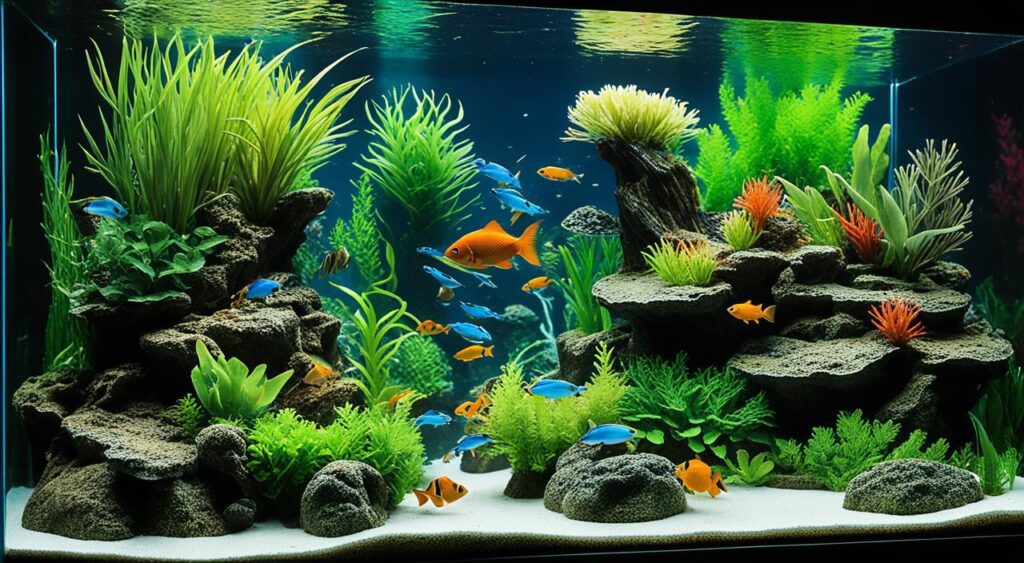
Creating a captivating aquascape involves mastering various techniques. As a beginner, understanding the fundamentals is essential to bring your aquatic dreams to life. In this section, I will provide you with a comprehensive guide to help you navigate the world of aquascaping and achieve stunning results.
Aquascaping Layout Tips
The layout of your aquascape sets the foundation for its overall aesthetic. Here are some expert tips to consider when creating your layout:
- Start with a plan: Visualize the desired layout and consider the size and shape of your aquarium.
- Use the rule of thirds: Divide the aquarium into three equal parts horizontally and vertically to create a visually pleasing composition.
- Create depth: Position taller plants or hardscape elements in the back to create an illusion of depth.
- Balance asymmetry: Achieve a balanced composition by placing elements of varying heights and shapes on either side.
| Aquascaping Layout Tips | Benefits |
|---|---|
| Start with a plan | Ensures a well-thought-out and organized layout. |
| Use the rule of thirds | Creates a visually appealing and balanced composition. |
| Create depth | Enhances the sense of perspective in the aquascape. |
| Balance asymmetry | Brings harmony to the overall layout. |
Aquascaping Plant Choices
Selecting the right plants for your aquascape is crucial in achieving the desired aesthetic. Here are some considerations:
- Choose plants based on their growth requirements: Consider light intensity, CO2 levels, and nutrient requirements.
- Create contrast: Combine plants with different leaf shapes, sizes, and colours to add visual interest.
- Consider maintenance: Select plants that are compatible with your skill level and available time for maintenance.
- Experiment with foreground plants: Utilize low-growing plants to create depth and a sense of scale.
Hardscape Artistry
Hardscape materials, such as rocks and driftwood, add character and structure to your aquascape. Here are some tips for hardscape artistry:
- Choose natural-looking materials: Opt for rocks and driftwood that mimic natural habitats.
- Avoid overcrowding: Place hardscape elements strategically, leaving space for plants and fish.
- Create focal points: Highlight key areas with eye-catching hardscape arrangements.
- Consider the proportions: Scale the size of hardscape elements to match the dimensions of your aquarium.
With these beginner-friendly aquascaping techniques, you can transform your aquarium into a mesmerizing underwater landscape. Stay tuned for the next section, where we will explore how to incorporate themes and colours into your aquascape for a truly immersive experience.
Exploring Aquascaping Themes and Colours
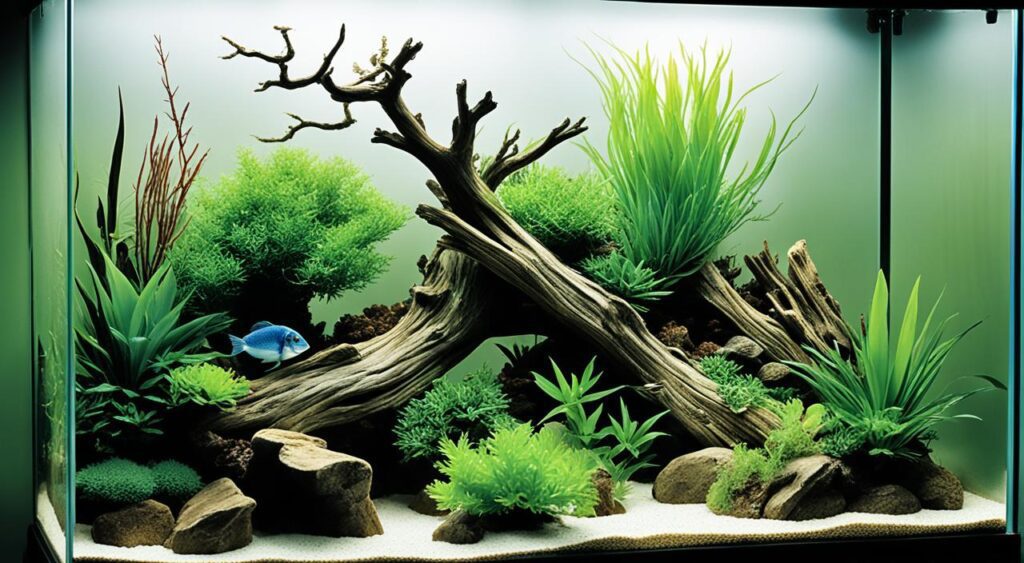
Incorporating themes and colours into your aquascape can enhance its visual appeal and create a captivating underwater garden. Let’s explore some inspiring aquascaping theme ideas and color schemes that will help you design a cohesive and aesthetically pleasing aquascape.
Aquascaping Theme Ideas
When selecting a theme for your aquascape, you have a myriad of options to choose from. Here are a few popular aquascaping themes:
- Natural Biotopes: Create a slice of natural habitat by replicating a specific aquatic ecosystem, such as a tropical rainforest or a rocky stream.
- Zen Gardens: Embrace tranquillity and simplicity by incorporating elements like carefully positioned rocks, minimalistic plants, and sand patterns.
- Underwater Forests: Design an aquatic equivalent of a lush forest, complete with tall stem plants, carpeting plants, and floating foliage.
These themes provide a starting point for your aquascape and allow you to develop a unique and captivating underwater environment. Remember to research each theme’s specific requirements and plant species to ensure the best results.
Aquascaping Color Schemes
Colour is a powerful tool in aquascaping and can significantly impact the overall aesthetic of your underwater garden. Here are some colour schemes to consider:
- Vibrant and Colorful: Use a variety of vibrant hues to create a visually stunning and lively aquascape. Play with contrasting colours and incorporate plants with different foliage shades.
- Serene and Monochromatic: Opt for a calm, peaceful ambience with a monochromatic colour scheme. Choose plants with similar shades of green, or go for a tranquil blue aquatic scape.
By strategically selecting and combining plant species based on their colours, you can create an aquascape that evokes specific moods and emotions, whether it’s vibrant energy or serene tranquillity.
Aquascaping Themes and Colors in Action
To further inspire you, here’s an example of an aquascape that combines a natural biotope theme with a serene and monochromatic colour scheme:
| Theme | Color Scheme |
|---|---|
| Natural Biotopes | Serene and Monochromatic |
This aquascape showcases a carefully arranged layout resembling a peaceful riverbed. The predominant green colour palette, courtesy of lush carpeting plants and moss, creates a serene and natural ambiance. Rocks and driftwood strategically placed replicate natural elements found in river ecosystems, further enhancing the biotope theme.
Experimenting with various aquascaping themes and colour schemes allows you to unleash your creativity and personalize your underwater masterpiece. Let these ideas inspire you as you embark on your aquascaping journey!
Enhancing Aquascape Composition
The composition of an aquascape plays a pivotal role in achieving a harmonious and visually appealing design. By understanding the principles of aquascape composition, you can create a well-balanced underwater garden that captivates the eye and evokes a sense of tranquility.
One of the fundamental principles of aquascape composition is the rule of thirds. This guideline suggests dividing your aquarium space into nine equal parts using imaginary gridlines and strategically placing key elements along these lines or at their intersections. This technique creates a balanced and visually pleasing layout, allowing the viewer’s eyes to naturally move across the aquascape.
In addition to the rule of thirds, focal points are another essential aspect of aquascape composition. A focal point is a visually dominant element that draws attention and serves as the centerpiece of your design. By placing a striking plant, a captivating rock formation, or an eye-catching driftwood piece as a focal point, you can create a captivating and dynamic composition.
Moreover, negative space is a powerful tool in aquascape composition. Negative space refers to the unoccupied areas of your aquarium deliberately left devoid of plants or hardscape elements. By incorporating negative space, you can create a sense of balance and emphasize the beauty of individual elements by giving them room to breathe.
Creating depth and perspective is another technique to enhance aquascape composition. By layering your aquatic plants and strategically positioning your hardscape elements, such as rocks and driftwood, you can create the illusion of depth. This technique adds visual interest and creates a three-dimensional effect, making your aquascape appear immersive and lifelike.
According to aquascaping expert Sowande Elan:
“A well-composed aquascape embodies the balance between natural elements and artistic vision. From the placement of plants and hardscape materials to the interaction of light and shadow, every aspect contributes to the overall beauty and tranquility of the design.”
By understanding and applying the key principles of aquascape composition, you can create visually stunning and well-balanced underwater landscapes that bring beauty and serenity to your aquarium.
Choosing the Right Materials for Aquascaping
The materials you choose for your aquascape play a vital role in its overall aesthetic and functionality. From selecting the right substrate for plant growth to choosing hardscape materials that create a natural and captivating scene, this section will provide you with insights on choosing the best materials for your aquascape. You’ll learn about different types of substrates, rocks, driftwood, and other decorative elements that can enhance the visual appeal of your underwater garden.
Substrates for Plant Growth
One of the key elements in a successful aquascape is the substrate. It serves as the foundation for your plants and provides vital nutrients and anchorage. Depending on the type of plants you intend to keep, you can choose from a variety of substrates such as nutrient-rich soil, clay, or sand. Each substrate has its own advantages and considerations, and understanding these factors will help you create an environment where your plants can thrive.
Hardscape Materials
Hardscape materials, such as rocks and driftwood, add visual interest and structure to your aquascape. They create natural-looking scenes and serve as focal points or hiding spots for aquatic creatures. When selecting hardscape materials, consider the size, shape, and texture of the objects. You can use rocks to create dramatic rock formations, or driftwood to simulate fallen branches in a forest. Just ensure that any hardscape materials you choose are aquarium-safe and won’t harm your aquatic inhabitants.
Decorative Elements
In addition to substrates and hardscape materials, adding decorative elements can enhance the aesthetic appeal of your aquascape. These elements can include live or artificial plants, colorful moss, or ornaments that complement your desired theme or style. Be creative and experiment with different combinations to achieve the desired visual effect.
Comparison of Aquascaping Materials
| Material | Advantages | Considerations |
|---|---|---|
| Substrate |
|
|
| Hardscape Materials |
|
|
| Decorative Elements |
|
|
By carefully selecting beginner aquascape materials and embracing hardscape artistry, you can create a visually stunning and harmonious underwater garden. The right combination of substrates, hardscape materials, and decorative elements will not only enhance the beauty of your aquascape but also provide a conducive environment for aquatic life to thrive.
Finding Inspiration from Aquascaping in Literature
Aquascaping has not only revolutionized aquarium design but has also made a significant impact in literature, serving as a wellspring of inspiration. Through classic literature and contemporary fiction, authors have skillfully incorporated the art of aquascaping to evoke human emotions and to transport readers into captivating underwater landscapes.
One of the notable examples of aquascaping in literature can be found in Jules Verne’s iconic novel, “Twenty Thousand Leagues Under the Sea.” Verne’s vivid descriptions of the mesmerizing underwater world inhabited by marine life showcase the power of aquascaping as a metaphor for exploration, mystery, and the vastness of the unknown.
Moreover, modern works of fiction also leverage the enchanting beauty of aquascaping to stimulate creativity and ignite the reader’s imagination. These contemporary authors seamlessly weave aquatic themes and underwater landscapes into their narratives, using them as a source of inspiration for characters, plot development, and symbolism.
Exploring aquascaping in literature opens a door to a realm where the wonders of the deep sea meet the realm of human emotions, dreams, and aspirations. By immersing ourselves in the literary representation of aquascaping, we gain new perspectives, invigorate our creative spirit, and discover boundless possibilities to bring the magic of underwater worlds into our own lives.
FAQ
What is aquascaping?
Aquascaping is the art of creating underwater landscapes in aquariums, capturing the beauty and tranquility of natural habitats.
What are some aquascaping styles and aesthetics I can explore?
There are various aquascaping styles and aesthetics to explore, from nature aquariums that mimic natural landscapes to artistic aquascapes that push the boundaries of imagination.
What techniques do I need to master for successful aquascaping?
To create a successful aquascape, it’s essential to master various techniques such as layout design, plant selection, and hardscape artistry.
How can I incorporate themes and colors into my aquascape?
You can incorporate themes and colors into your aquascape by choosing specific design elements, such as natural biotopes or Zen gardens, and utilizing a well-thought-out color scheme.
What are the key elements of aquascape composition?
The key elements of aquascape composition include the rule of thirds, focal points, use of negative space, and creating depth and perspective.
What materials should I choose for my aquascape?
When choosing materials for your aquascape, consider factors such as substrate for plant growth, rocks, driftwood, and other decorative elements that enhance the visual appeal and functionality of your underwater garden.
How has aquascaping influenced literature?
Aquascaping has found its place in literature as a source of inspiration, with authors using aquatic themes and underwater landscapes as metaphors for human emotions and to ignite the reader’s imagination.

